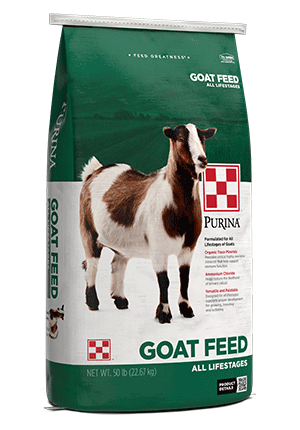
Urinary Calculi in Goats
Wellness : Health

In goats, clinical obstructive urolithiasis, or urinary calculi, is most frequently seen in young, early-castrated male goats fed high-grain diets, although it can also occur in intact males and may result in their destruction as breeding animals.
When the obstruction goes uncorrected, rupture of the bladder or urethra usually results within 24 to 48 hours, allowing urine to leak into the surrounding tissues. At this point, only surgical intervention will save the animal, and the success rate is low. It is far better to intercede before the condition gets this far.
Purina Animal Nutrition has developed goat feeds with optimal calcium-to-phosphorus concentrations and added ammonium chloride, but we encourage you to keep in mind that it is important to use all of the management options to optimally control incidence of urinary calculi – relying on just one, such as the presence of a urinary acidifier in the diet, may provide disappointing results.
What are urinary calculi?
Urinary calculi are “stones” formed by an agglomeration of minerals (primarily phosphorus) in the ureter, the tube which leads from the bladder to the exterior of the animal. Males have a long ureter with a sharp curvature which makes them much more prone than females to develop urinary stones.Signs of urinary calculi in goats
Clinical signs of urinary calculi include restlessness and anxiety. Tail twitching is an early sign. There may be excessive vocalization and animals will strain frequently and forcefully to urinate. Marked abdominal pressure may produce some degree of rectal prolapse. Inexperienced owners may assume that the goats are constipated and medicate goats inappropriately rather than seeking veterinary attention. Drops of bloody urine and (or) crystals may be seen attached to preputial hairs. Goats with partial obstruction may be able to void small intermittent streams of urine, but show discomfort. This is an incredibly painful and life-threatening situation that will not resolve on its own – if you see any of these signs, immediately seek the services of a veterinarian.When the obstruction goes uncorrected, rupture of the bladder or urethra usually results within 24 to 48 hours, allowing urine to leak into the surrounding tissues. At this point, only surgical intervention will save the animal, and the success rate is low. It is far better to intercede before the condition gets this far.
Causes of urinary calculi in goats
There are many predisposing factors which contribute to urinary calculi formation in goats:- Early castration. The hormone testosterone influences diameter growth of the ureter, so the earlier the goat is castrated, the slimmer the ureter and the more prone it will be to blockage by a stone. It is recommended to wait until at least 4 months of age – and preferably 5 or 6 -- to castrate young bucks.
- Decreased water intake. Anything that causes the goat to drink less water will result in more concentrated urine and a greatly increased chance of urinary calculi development. Withholding water from show goats to enhance their muscular appearance has been known to have fatal results. Always provide goats with an unlimited supply of clean, fresh water. Provide salt to enhance water intake – the minerals in salt do not contribute to development of urinary calculi. Since water sources can occasionally be high in minerals, it may be wise to have your water source tested and then take steps to alleviate any problems.
- High phosphorus intake. Grains and grain-based feeds tend to be higher in phosphorus, the main mineral in calculi formation.
- Breed. Pygmy goats, due to their diminutive size (and therefore smaller ureters), are especially prone to this condition. Avoid grain-based diets and do not feed high-grain treats to pygmy goats.
- Forage that has been fertilized with high-phosphorus sources. It is common in many areas to fertilize with chicken litter, resulting in forages that are quite high in phosphorus. It is always wise to have forages tested so that, if necessary, calcium sources can be added to the diet to ensure that the ratio of phosphorus to calcium does not become unbalanced. Calcium content of the total diet should be 2 to 2.5 times that of the phosphorus.
Purina Animal Nutrition has developed goat feeds with optimal calcium-to-phosphorus concentrations and added ammonium chloride, but we encourage you to keep in mind that it is important to use all of the management options to optimally control incidence of urinary calculi – relying on just one, such as the presence of a urinary acidifier in the diet, may provide disappointing results.

.png?width=300&height=430&ext=.png)


